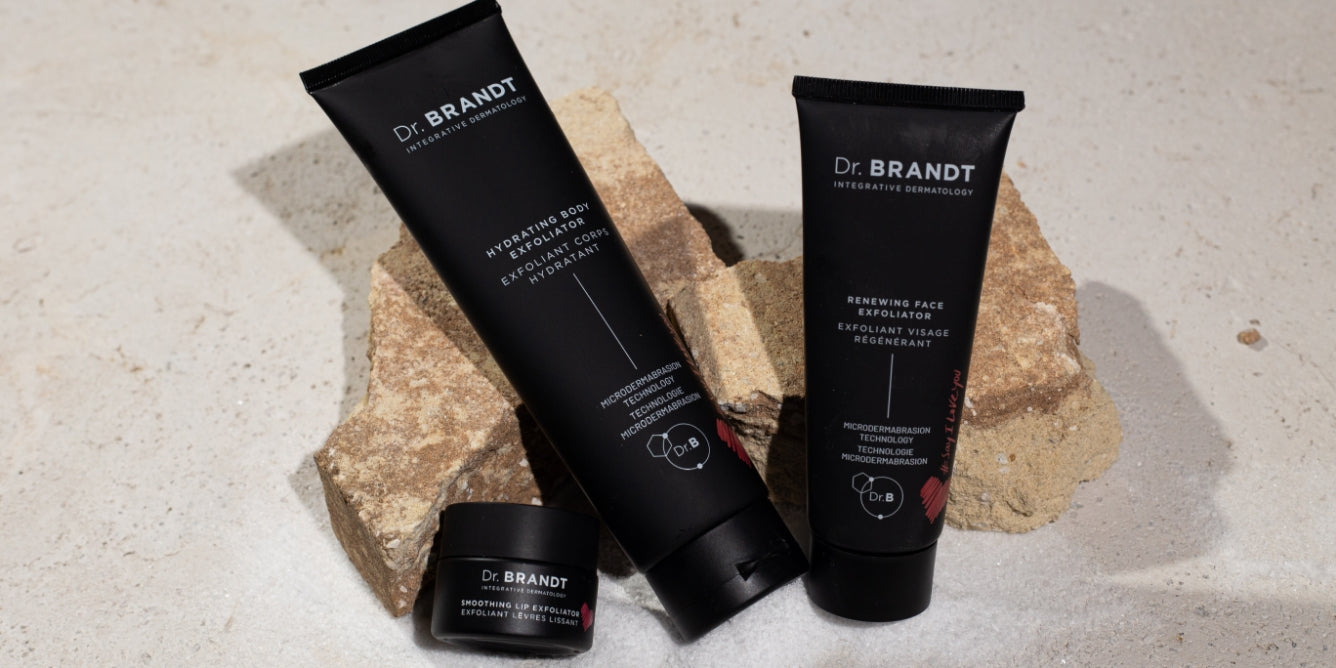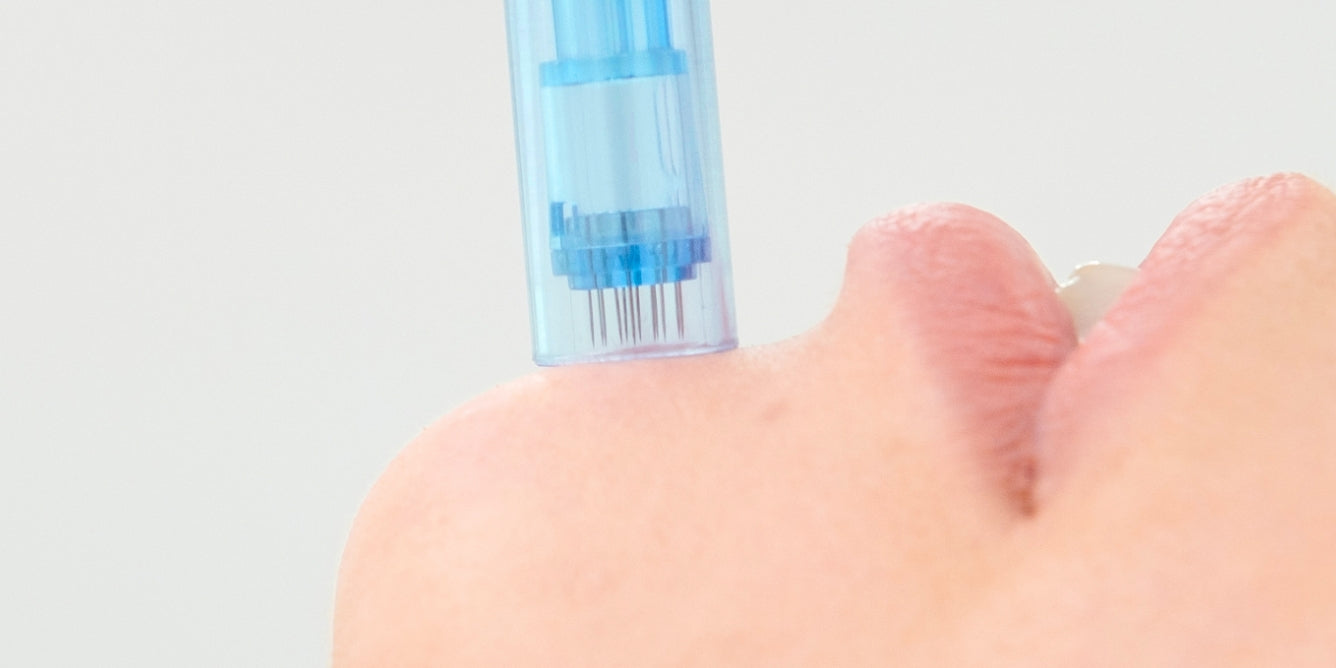
Whether you prefer manual buffing or are all about those AHAs, regular exfoliation can help you achieve softer, smoother, brighter skin. That said, it’s important to do it right—ie. not too often, and using quality exfoliating products that won’t shred your skin barrier. The updated Microdermabrasion collection features threeadvanced exfoliating formulasoptimized for different areas of skin—face, body, and lips. Below, our expert-written guide to proper exfoliation for every part of you.
WHY EXFOLIATE?
First, a word on skin structure. The skin is made of two main layers: epidermis and dermis. Over time, skin cells move up from the deepest layer of skin until they reach the surface, die, and naturally shed. In other words, your skin renews itself naturally every 4 to 6 weeks. Often though, the dead skin cells don’t shed properly, leading to pore-clogging, a dull-looking complexion, or dry, scaly patches of skin. Exfoliation is a way of nudging the process along, speeding up cell turnover by and removing this build-up. This is how exfoliation helps improve skin texture and tone.
HOW EXFOLIATING BOOSTS YOUR SKINCARE ROUTINE

Aside from helping to unclog pores, improve skin texture, and reveal brighter skin, exfoliation can also help your other skincare products penetrate better. For those with acne-prone skin for example, exfoliants featuring AHAs or BHAs like salicylic acid, glycolic acid, and malic acid can work synergistically with other topical skincare products such as benzoyl peroxide, sulfur, and retinol/retinoids, for maximum pore-clearing benefits. Microdermabrasion Face features a combination of fine buffing grains and AHAs so you get the benefits of both gentle manual and chemical exfoliation.
TYPES OF EXFOLIATION
There are two main types of exfoliation: physical and chemical. Physical exfoliation essentially boils down to manual scrubbing. Some do this using a muslin washcloth while washing, using soft brushes with rotating heads, or using cleansers containing beads or buffing grains. Chemical exfoliation meanwhile uses gentle peeling ingredients like salicylic, glycolic, mandelic, lactic, malic, and citric acids to loosen dead skin cells without the need for scrubbing. It can help provide more even exfoliation in areas you may have missed while buffing.
WHAT’S THE BEST TIME TO EXFOLIATE?
Generally speaking, the best time to exfoliate is in the evening after you’ve washed your face with a gentle cleanser. This way, you minimize the risk of exposing your newly-exfoliated skin barrier to external aggressors like sunlight, pollution, and dry air. Whether you opt for chemical or physical exfoliation, it is absolutely essential to follow up by protecting and hydrating with skincare serums and your go-to moisturizer. (Apply serums first, as they tend to be lighter in texture, followed by your face cream to help lock in moisture.)
HOW OFTEN SHOULD YOU EXFOLIATE?
For most skin types, exfoliating two times per week is adequate. Exfoliating too frequently or too aggressively can lead to microscopic tears or cracks in the stratum corneum, which will make the skin feel tight, irritated, or even painful. Though it may seem counterintuitive, over-exfoliation can also lead to excessive sebum production as skin tries to compensate for an oil-stripped skin barrier. People with sensitive skin may need to reduce exfoliation to just once per week, to minimize the risk of irritation or contact dermatitis. Those using topical retinol or serums containing AHAs/BHAs should limit their exfoliation to once a week, since these ingredients also encourage shedding of dead skin cells. The rule of the thumb is this: if your skin feels very tight, or even tingles after exfoliation, then you need to reduce the frequency or be gentler.
TIPS ON PROPER EXFOLIATION FOR FACE, BODY, AND BEYOND
Not all the skin on your body is created equal: some areas are thinner, requiring a more delicate exfoliator, while thicker areas of skin like knees, elbows, or the back of your arms demand more intensive smoothing power. Here are a few tips for good exfoliation, organized by area:
FACE
- Be gentle with scrubs: no need to use excessive pressure. A well-made scrub should do most of the work for you. Gentle circular motions with minimal pressure should suffice. Formulas like Microdermabrasion Face include AHAs precisely to help provide comprehensive, even exfoliation without the need for aggressive scrubbing.
- Using a brush exfoliator? Keep it clean by washing regularly with warm water and soap.
- Avoid exfoliating in areas where skin is extra-delicate, such as around the eyes and nose.
- Sensitive skin? Be sure to patch test any new exfoliator, especially chemical ones that rely on AHAs or BHAs.

BODY
- Suffering from dry skin, or dealing with bumpy areas (known as keratosis pilaris)? Exfoliation can definitely help. Just be sure to limit it to 2-3 times per week as these conditions are easily irritated by over-exfoliation.
- Always exfoliate post-shave: it helps prevent ingrown hairs.
- Look for physical exfoliators specifically-designed for the body. Our go-to formula Microdermabrasion Body features larger buffing grains that are much more effective on thicker areas of skin.
- Lock in moisture! Always apply moisturizer post-exfoliation to prevent irritation and keep skin nourished. Certain formulas (including Microdermabrasion Body) are even enriched with hydrating ingredients that help protect your newly-scrubbed skin.

LIPS
- Put down the toothbrush! Hygiene aside, this isn’t the best way to ensure even exfoliation. Instead, try a formula like Microdermabrasion Lips, an expert balm designed for dual-action polishing and softening, specifically adapted to delicate lip skin.

For professional-level smoothing inspired by in-office microdermabrasion procedures, Microdermabrasion by Dr. BRANDT has you covered from head to toe. Shop it now here.




Leave a comment (all fields required)